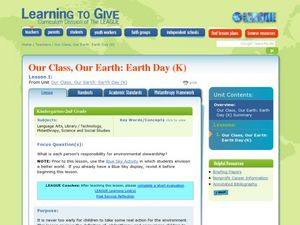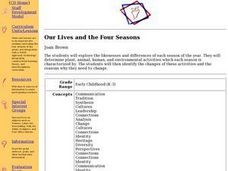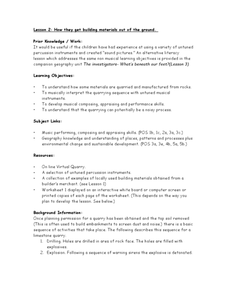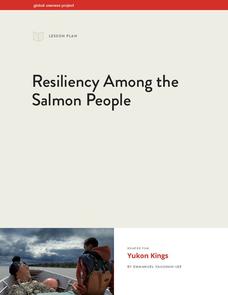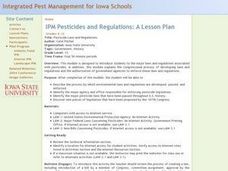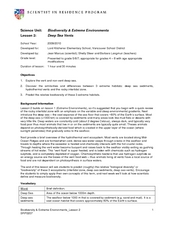Curated OER
Powering a Green Earth
Pupils compare and contrast renewable and nonrenewable energy. In this environmental science lesson, students discuss the importance of going green. They identify the different components in a power grid system.
Curated OER
Arbor Day Across the United States
Students perform research about hardiness zones used to guide planting. They read a hardiness zone color-key map and create their own color-key maps to show when different states celebrate Arbor Day.
Teach Engineering
Dirty Decomposers
Do not let the class just sit and rot. Pupils learn how decomposition and nutrient recycling is important to an ecosystem. Groups design an experiment to determine how environmental conditions affect decomposition. They develop a poster...
Curated OER
Forms of Energy
Students complete a series of activities related to forms of energy. In this energy lesson plan, students look at forms of energy in their school, how energy is conserved and used efficiently, how magnets are used to generate...
Curated OER
Developing Environmental Awareness Through Problem Solving
Students examine the relationships among living and non-living parts of the environment. Using their senses, they identify the objects in their classroom. In groups, they participate in experiments to discover where electricity comes...
Curated OER
Our Class, Our Earth day
Young scholars understand the importance of participating in recycling and clean-up efforts in the community. In this recycling instructional activity, students respond to questions after reading "The Wartville Wizard" by Don Madden....
Curated OER
Digging Up The Facts
Students research environmental issues. In this environmental lesson, students use the Internet to research an environmental problem and list ten facts about it. Students write a summary of facts.
Curated OER
Dreaming of Gardens
Students demonstrate ways to be an environmental philanthropist. In this philanthropy lesson, students read The Gardener and Just a Dream and compare the two books. Students discuss ways the characters demonstrated environmental...
Curated OER
Treacherous Trash
Middle schoolers recognize the harmful effects people have on the environment. In this environmental lesson, students simulate water pollution clean-up by using tangled objects and untangling them in a cooperative group. Middle schoolers...
Curated OER
A Day at the Beach-Why Did We Do It?
Middle schoolers investigate pollution at the beach. In this environmental lesson, students participate in a beach clean-up and calculate the weight of the debris collected. Middle schoolers write a reflection in their journal about...
Curated OER
Our Lives and the Four Seasons
Students compare and contrast the four seasons. Using this information, they determine the plant, animal and environmental activities that can be enjoyed in each season. They discuss why the seasons must change and how humans adapt to them.
Curated OER
Talking Trees
Students investigate the ecosystem. In this environmental lesson, students read the book The Tree by Dana Lyons and list ways to save the trees. Students create a poster about saving the trees.
Curated OER
Reduce, Reuse, Recycle
Students develop a recycling plan. In this environmental instructional activity, students develop a recycling plan for their school. Students write an outline of the plan to present to their class.
Curated OER
Landscape Garden Makeover
A project-based learning plan focuses on landscapes in the community. After identifying problems, such as dead trees or misplaced automatic sprinklers, learners design solutions, contact local organizations to fix the problems, and do...
Curated OER
How They Get Building Materials Out of the Ground
Students experience a virtual quarry. For this science musical lesson plan, students understand how materials are quarried and manufactured from rocks, musically interpret a quarrying sequence with untuned musical instruments, and...
Curated OER
The Lorax
Third graders identify and list five problems presented in The Lorax by Dr. Seuss. They relate these problems to current environmental issues and debate how to make a difference then participate in different activities to improve their...
Curated OER
Understanding the Roots
Students investigate the parts of a flower. In this earth science lesson, students read the book The Magic School Bus Plants Seeds and identify various plant parts. Students construct a model of a flowering plant from various art supplies.
Curated OER
Decomposers- Nurse Logs
Students investigate temperate forest ecosystems. For this environmental lesson, students discover different forms of decomposition and its effect on the environment.
Global Oneness Project
Resiliency Among the Salmon People
Is losing cultural traditions the cost of social progress, or should people make stronger efforts to preserve these traditions? High schoolers watch a short film about the native Yup'ik people in Alaska and how they handle the shifts in...
Learning to Give
It's Never Too Late: Air Quality
What are the causes and effects of pollutants on the quality of the air we breathe? Groups research emission standards, emission controls, career opportunities in the area of air quality control, and things government and individuals can...
Curated OER
Pesticide Laws and Regulations
Students explore the laws and regulations of pesticides. For this pesticides lesson, students research how laws are made and identify the agencies responsible for enforcing the laws. Students research the Internet for laws and bills...
Curated OER
An Oil Spill Primer for Students
In this Gulf oil spill learning exercise, learners examine a 4-page article regarding basic facts about the oil spill as well as photographs of clean-up efforts.
Curated OER
Stream Ecology In Wisconsin and Puerto Rico
Students identify the different types of water and explain in what proportions they exist on Earth. They identify and correctly label the parts of the water cycle and how these parts interact with each other. Students identify the...
Curated OER
Deep Sea Vents
Students study the vent and non vent deep sea and see the differences in habitats. In this investigative lesson students complete a worksheet and work in groups.







